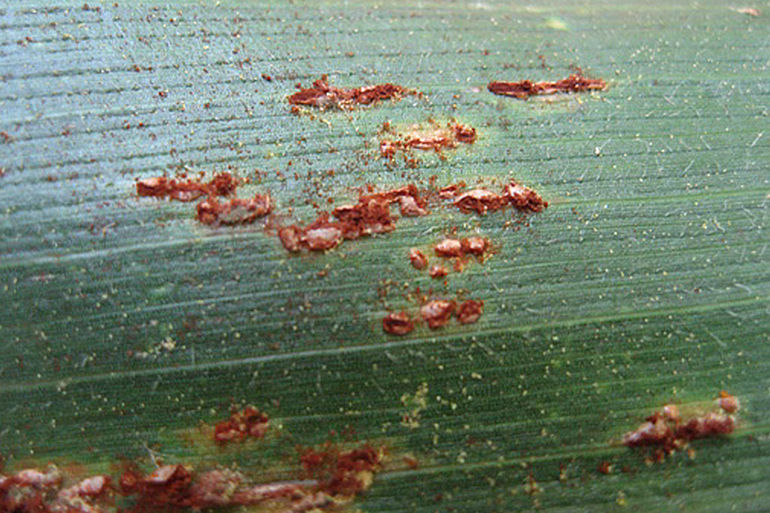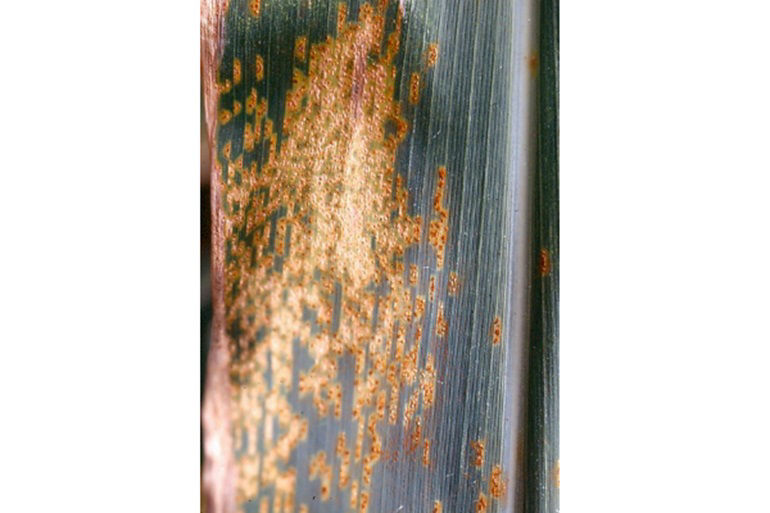Recognizing Corn Rust Diseases
January 31, 2018


Two types of corn rusts occur in the U.S. Corn Belt: common corn rust, caused by the Puccinia sorghi fungus, and southern corn rust, caused by the Puccinia polysora fungus.
The two corn rust diseases have similarities and can quickly increase in severity. Rapid spread of corn rusts occurs when favorable environmental conditions, such as ideal temperatures and moisture, exist for extended periods during in the growing season. Both corn rust diseases survive as parasites on living tissue, which means they don’t overwinter in Midwest states. Instead, common and southern corn rust spores migrate north each year on wind currents from southern climates.
Identification and Lifecycle
The two types of corn rusts differ in location on the leaf tissue as well as color and shape of the pustules, which helps to identify the type of rust infection.
Primary features that distinguish common corn rust from southern corn rusts include:
- More scattered distribution on corn leaves
- A more round shape and a red-brick color
- Lesions that appear on both lower and upper leaf surfaces
Primary distinguishing characteristics of southern rust include:
- More dense pustule clusters
- Smaller pustules that are orange to light brown in color
- Lesions that primarily develop on upper leaf surfaces
The lifecycle of both corn rusts relies heavily on optimal temperatures. Common rust fungus thrives in cooler weather with temperatures ranging from 61–77°F. In susceptible corn hybrids, cool evenings with dew formation can cause severe infection. Dry, hot weather will cause common corn rust spores to become inactive. Conversely, southern corn rust prefers warmer temperatures between 77–82°F.
Under favorable environmental conditions, the infection cycle of corn rusts will persistently repeat and lead to secondary infections. In as few as seven days, thousands of spores reproduce from a single pustule to infect a corn plant. Cycles can continue and rapidly reach epidemic intensities.
Crop Damage
In most years, common corn rust poses a somewhat lesser threat than southern corn rust. For example, Purdue University Extension reported in 2013 that the top 21 U.S. corn states and Ontario, Canada, sustained losses of 52.9 million bushels from common corn rust versus losses of 57.6 million bushels from southern corn rust.
When severe secondary infections occur, corn rusts can hinder grain fill from premature defoliation and loss of photosynthesis, which is needed to feed developing ears. Furthermore, leaf tissue is ruptured by rust pustules, reducing the corn plant’s ability to absorb water and nutrients. These effects may also lead to stalk rot and lodging.
Managing Corn Rusts
Farmers can benefit from several options to manage corn rusts, including hybrid selection scouting, cultural practices and fungicides. A combination of these crop protection practices provides optimum security to enhance corn yields and should be implemented to sustainably manage corn diseases.
Hybrid selection
Choosing corn hybrids with genetic disease resistance offers the best economical and effective defense against corn rusts and other foliar diseases. Although no hybrids provide resistance to all diseases, even partial resistance goes a long way in protecting corn yields. Be aware that resistant ratings for hybrids may not all be available, particularly in the Midwest, where corn rusts don’t pose a threat every year. Check with local agronomists and seed dealers to learn which hybrids might provide the desired level of disease resistance.
Scouting
Early and frequent scouting for diseases is a routine best management practice to tackle problems before they lead to economic damage. In the case of common corn rust and southern corn rust, look for lesion symptoms in the lower and upper plant leaves when environmental conditions are optimal for disease development. To aid scouting, keep in mind that the two rusts differ in development, fungi species, favorable environmental conditions and size, location and color of pustules (lesions). It’s helpful to review guidelines to distinguish between the two rusts.
Cultural practices
Unlike other diseases, crop rotation does not help prevent corn rust development. Corn rusts don’t overwinter and need living tissues in tropical and subtropical climates to survive and disperse by wind to northern climates in spring and summer. In regions where rusts are a more consistent occurrence, farmers can limit rust problems by avoiding late planting or choosing short-season hybrids.
Fungicides
Foliar fungicides may be cost-effective in high-yield corn as a risk-management tool for rusts and other corn diseases. For maximum effectiveness, it’s best to use fungicide treatments at the first sign of disease. If applications are to be made after V8 but before tassel emergence, do not include an adjuvant in the tank.
Delaro® 325 Fungicide offers preventative and curative defense against yield-robbing diseases, including gray leaf spot, northern corn leaf blight, anthracnose leaf blight and southern rust. This versatile fungicide has application flexibility — at-tassel timing (VT to R2), in combination with a herbicide (V4 to V7) and/or in between (V8 to VT). Delaro can be applied by air, ground or by chemigation and can be mixed with adjuvants, herbicides, insecticides and micronutrients.
Before applying any fungicide, please read the entire label for the best possible results and to confirm that the product is effective on the disease you need to control. Not every product is suitable for every situation, and correct application technique will ensure the best results.